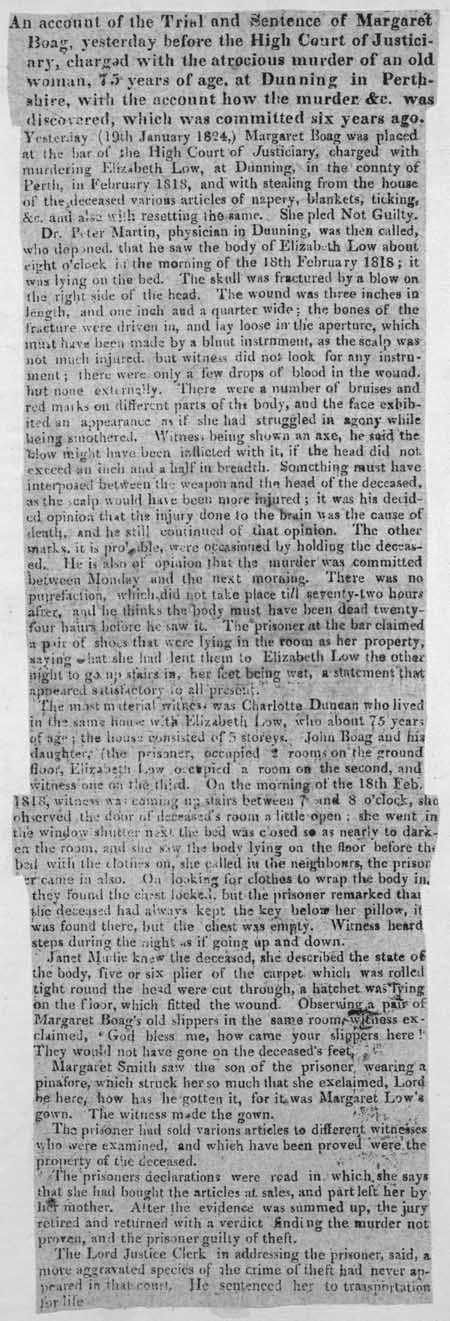Transcription
An account of the Trial and Sentence of Margaret
Boag, yesterday before the High Court of Justici-
ary, charged with the atrocious murder of an old
woman, 75 years of age. at Dunning in Perth-
shire, with the account how the murder &c. was
discovered, which was committed six years ago.
Yesterday. (19th January 1824,) Margaret Boag was placed
at the bar of the High Court of Justiciary, charged with
murdering Elizabeth Low, at Dunning, in the connty of
Perth, in February 1818, and with stealing from the house
of the deceased various articles of napery, blankets, ticking,
&.c. and also with resetting the same. She pled Not Guilty. Dr. Peter Martin, physician in Douning, was then called,
who depened. that he saw the body of Elizabeth Low about
eight o'clock i n the morning of the 18th February 1818; it
was lying on the bed. The skull was fractured by a blow on
the right side of the head. The wound was three inches in
length, and one inch and a quarter wide: the bones of the
fracture were driven in, and lay loose in the aperture, which
must have been mads by a bhuut instrnment, as the scalp was
not much injured, but witness did not look for any instru-
ment; there were only a few drops of blood in the wound.
but none externally. There were a number of bruises and
red marks on different parts of the body, and the face exhib-
ited an appearance as if she had struggled in agony while
being smothered. Witness being shown an axe, he said the
blow might. have been inflicted with it, if the head did not.
exceed an inch and a half in breadth. Something must have
interposed between the weapon and the head of Che deceased,
as the scalp would have been more injured ; it was his decid-
ed opinion that the injury done to the brain was the cause of
death, and he still continued of that opinion. The other
marks, it is probable, were occasioned by holding the deceas-
ed.. He is also of opinion that the murder was committed
between Monday and the next morning. There was no
putrefaction, which did not take place til1 seventy-two hours
after, and he thinks the body must have been dead twenty-
four haurs before he .saw it. The prisoner at the bar claimed
a pair of shoes that were lying in the room as her property,
saying what she had lent them to Elizabeth Low the other
night to go. up stairs in, her feet being wet, a. statement that
appeared Satisfactory to all present. The most material witness was Charlotte Duncan who lived in the same house with Elizabeth, Low, who about 75 years of age ; the house consisted of 5 storeys. John Boag and his daughter (the prisoner, occupied 2 rooms on the ground floor, Elizabeth Low occupied a room on the second, and witness one on the third. On the morning of the 18th Feb. 1818 witness was comming up stairs between 7 and 8 o'clock, she observed the door of deceaseds room a little' open ; she went in this window shutter next the bed was closed s. as nearly to dark:- on the room, and she saw the body lying on the floor before bed with'the clothes on, she called in the neighbours, the prison er came in also. On looking for clothes to wrap the body in, they found the chest, looked, but the prisoner remarked that the deceased had always kept the key below her pillow, if was found there, but the chest was empty. Witness heard steps during the night ,as if going up and down. Janet Madie knew the deceased, she described the state of
the body, five or six plier of the Carpet which was rolled
tight round the head were cut through, a hatchet was lying
on the floor, which fitted the wound. Observing.a pair of
Margaret Boag's old slippers in the same room witness ex-
claimed, 'God bless me, how came your slippers here !
They would not have gone on the deceased's feet Margaret Smith saw the son of the prisoner, wearing a
pinafore, which struck her so much that she exclaimed, Lord
he here, how has he gotten it, for it was Margaret Low's
gown. The witness made the gown. The prisoner had sold various articles to different witnesses
who were examined, and which have been proved were.the
property of the deceased. The prisoners declarations were read in which she says
that she had bought the articles at sales, and part left her by
her mother. Alter the evidence was summed up, the jury
retired and returned with a verdict finding the murder not
proven, and the prisoner guilty of theft. The Lord Justice Clerk in addressing the prisoner, said, a
move aggravated species of the crime of theft had never ap-
peared in that court.He sentenced her to transportation
for life
View Commentary | Download PDF Facsimile
|


